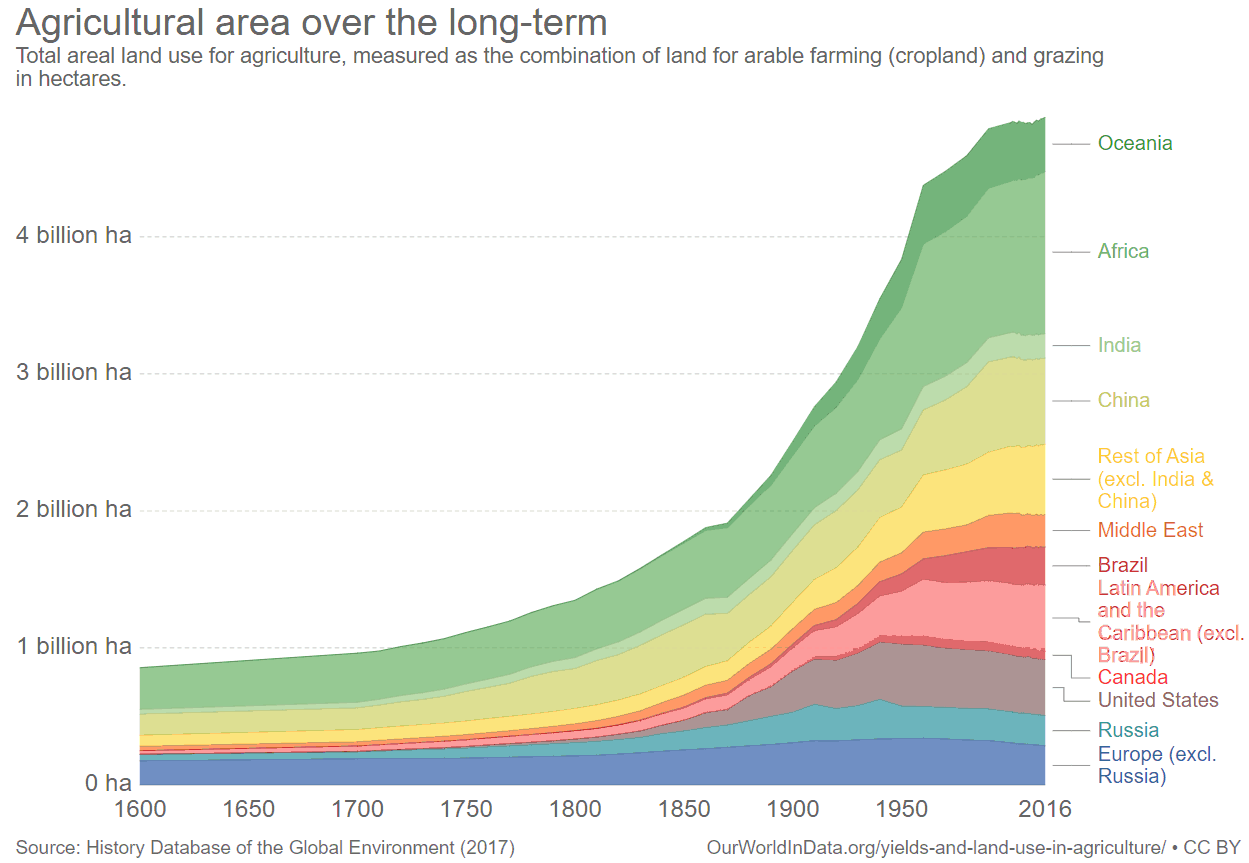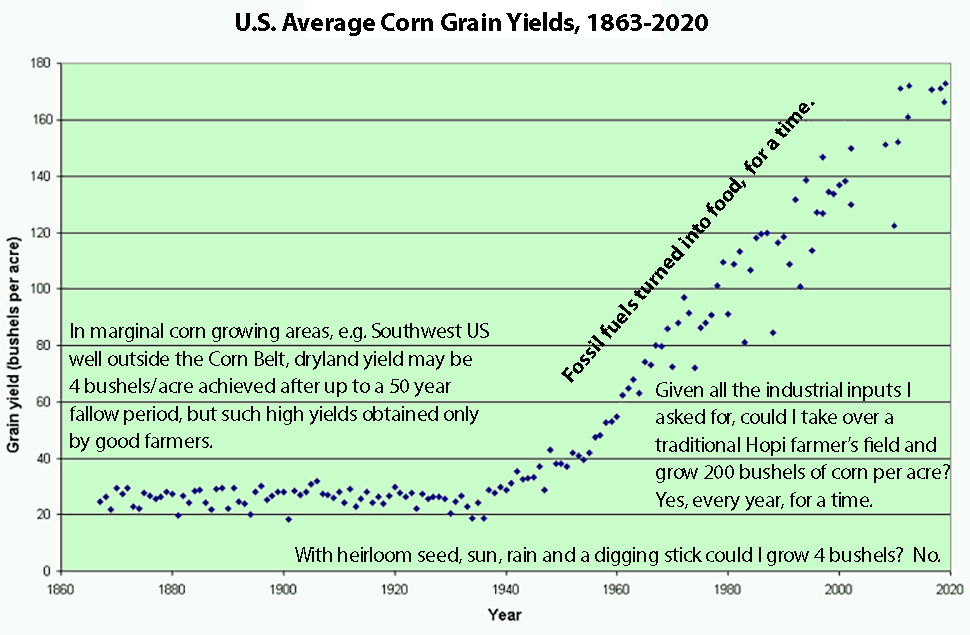
SUNDAY, AUG 30, 2020: NOTE TO FILE

Management of Agroecosystems
Food enough for all
Eric Lee, A-SOCIATED PRESS
TOPICS: NON-ENERGY-BLIND AGRICULTURE, FROM THE WIRES, NOT POSTERITY BLIND
Abstract: All agricultural production systems, from unsustainable modern industrial agriculture on such arable and pasturable lands as fossil fuel inputs make possible (for a time) to kitchen gardens and 'weed' control by a family goat or cow, are part of a surrounding ecosystem/biosphere and should be viewed as agroecosystems managed by humans for humans (or mismanaged for unsustainable short-term production). No one engaged in conventional agriculture sees themselves as managing an agroecosystem's energy and material flows as the Odum brothers sought to promote from the 1950s on. Alternative to conventional energy-blind agriculture are other modern energy-blind agricultural production systems being oversold as putatively viable alternatives that absolutely work but will not scale up. Low intensity forager-farmer agroecosystems are viable.
COOS BAY (A-P) — Humans currently feeding from the trough of modern agribusiness dependent on fossil fuel inputs might want to know what the sustainable carrying capacity of the planet is for humans. Answers vary. Do you want to know the maximum number of humans Earth could support if all environmental productivity is maximally (but sustainably) diverted to humans and mutualist species to maximize their populations at the expense of all others? (Credible answer, about 600 million.) Or some could ask how many humans can live prosperously and sustainably on Earth as the millennia pass without reducing biodiversity due to over competition for environmental productivity? (Maybe 35 million.)
For a prosperous way down to a viable ecolate civilization functional genes and memes need to be conserved, i.e. information. Some technology may be needed, e.g. paper production and perhaps some electricity in the form of AA/AAA rechargeable batteries, 5-15W solar panels for individual use (to provide 40-60Wh/day/person) or in-stream hydro/wind or biomass powered community generators to provide each person with some electrical services such as LED personal lighting to, for example, read at night by or be out and about at night without a smoking torch or oil light. Perhaps MP3 technology could be of value other than to entertain.
Electricity has high transformity value. Globally, pockets of high tech clustered around hydroelectric dams may be worth saving if the sapience to use tech within limits is acquired and preserved. The ability to model complex systems may be adaptive and enable humans living in complex society to be evolvable, i.e. someday there might be "a human on the planet that really does understand it and can live with it properly. That's the source of my optimism." —James Lovelock
Information has the highest value (transformity) and there is no information conservation law of the universe. It (all that has been learned in the last seven thousand years or so, much of it in the last 300 years) can go away along with all literate, numerate, and ecolate humans. If the only humans to make it through the coming bottleneck are those with the most ammo in their bug-out bunker, then game over even if extinction is sidestepped. Conserving information and functional humans who can take it in and pass it on is the prize to keep our eyes on.
"If society does not succeed in changing attitudes and institutions for a harmonious descent, the alternative is to prepare information packages for the contingency of restart after crashing..., seek out the condition now that will come anyway." —H.T. Odum
1) How much food does it take to keep one person alive?
About 2000 kcal/woman, 2500 kcal/man per day. That would be about 3,100 grams of potatoes or 900 grams of bread per day, and a human could live a day (or month) on bread or potatoes alone. If squash were all you had to eat, you'd have to eat 5,500 grams/day (over 12 lbs. of cooked squash).
2) How much food can be grown per hectare of land using only the sun and human/animal energy?
Potatoes are the most productive of staple crops. Based on an average intake of 2250 calories a day, you'll need to grow 657,000 calories of potatoes as staple food (if 80% of diet) a year plus 171,400 calories from other plant and animal foods. That’s about a ton of spuds per person (allowing for waste), requiring 270+ square meters (2900 square feet or 0.066 acres) of land for potatoes per person under optimal conditions which are uncommon. Potatoes are exceptionally nutritious, store, and produce over three times more calories per area than wheat.
For other staple foods (e.g. rice, corn/beans/squash) grown mostly dryland under regionally optimal conditions, figure five times more area (and up if animal power is used) per person using much less of Earth's land surface than currently with fallow/green manure periods of 1-50 years post crop.

3) How much of this land is available on Earth?
Including areas such as parts of the SW USA where traditional Hopi farmers can produce up to 4 bushels of corn per acre (plus some beans and squash every 20-50 years vs 176 bushels/acre average of corn by industrial agriculture every year), about 4,900,000,000 hectares are currently made (using vast amounts of unsustainable energy) arable/pasturable at some level of productivity (made vastly less without industrial inputs) of which about 1,400,000,000 hectares are currently arable assuming modern unsustainable agricultural practices are used. With more fossil fuel energy diverted to agriculture (up from about 30% of total now), agricultural productivity could be increased by turning more fossil fuel into food, as in China and India in recent decades, but only for a time.
Forests cover 31 percent of the global land area. Approximately half the forest area is relatively intact, of which more than one-third is primary forest (old growth). The total forest area is 4.06 billion hectares, but forests are not equally distributed around the globe and are rapidly being converted into agricultural lands or into tree farms for industrial wood production, not food, which is not usually considered agriculture as above, but siliculture is as fiber production (e.g. cotton) is clearly agricultural land use. The destruction of the planet’s forests is ongoing and is and will have a ‘bad’ outcome for life on Earth including humans whose pursuit of short-term self interest is rapidly degrading the planetary life-support system.
The State of the World’s Forests 2020

Note: The 'I' referred to above is my trained-to-be-an-agronomist self who, being above average, could grow over 200 bushels of corn per acre IF given all the inputs I asked for. Would the sale of corn cover cost? In northern Arizona? No. In the Corn Belt, yes. With another six years of education could I grow 4 bushels per acre dryland in Arizona? Maybe, if I apprenticed myself to a Hopi farmer. My prior education would allow me to perhaps understand why what the Hopi farmer did worked. In another ten years I might be able to do some ag station type research and increase production to 4.1 bushels/acre. Maybe.
Due to long-term soil salinization in arid and semi-arid areas (about 40% of total, e.g. California's San Joanquin Valley and the former Fertile Crescent), irrigation is not sustainable and elsewhere is unneeded (though rainwater could be stored for occasion use), so assume no pumping of groundwater and mostly dryland farming as the transformity value of limited electricity is too high.
To leave room for Nature, assume one-fifth of land that could be used by humans for humans (no marginal land) actually is managed. Assume only land having naturally high productivity on rainfall is managed for long-term productivity, e.g. any soil where the rate of erosion exceeds the rate of soil formation is not used even if it could be for centuries. Assume no fossil fuel or inputs of high value electric energy is being turned into food. Assume moderate use of energy slaves including humans and animals. Assume humans appropriate no more land (primary production) than needed such that usage does not measurably reduce species diversity within their watershed management unit. This implies that human activity within their claimed twenty percent has to be managed to mold 'individual behaviour into a plan of actions or avoidances that are oriented toward the maintenance of a viable equilibrium between Man’s demands and Nature’s resources'.
Without fossil fuel inputs, direct and indirect, figure maybe 1/10th current industrial agriculture's output per unit of land but only by using forced human labor (most of a 600 million population as pleasant slaves, serfs, or wage-slaves) and animal labor. Or maybe figure on a low intensity agroecosystem using 1/10th as much land as could be, that leaves room for Nature and spare time for humans to learn to love and understand the world system (e.g. to educate themselves as autodidacts with access to information). Figure Earth could maybe support 20-60 million forager/farmers provided empire-building is prevented. Empire-building selects for elite exploitation of commoners and conquest/exploitation of environmental productivity and neighboring humans where population growth has a short-term payoff and overpopulation density results in a behavioral sink (for a time).
